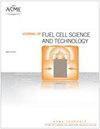天然气间接重整和二氧化碳捕集的高效SOFC动力循环
引用次数: 14
摘要
在寻求最高理论效率的推动下,过去几年有几项研究调查了燃料电池在天然气发电领域的应用,并进行了二氧化碳捕获。大多数提出的动力循环依赖于高温燃料电池,即固体氧化物燃料电池(SOFC)和熔融碳酸盐燃料电池(MCFC),基于混合燃料电池和燃气轮机循环的概念。因此,高温燃料电池集成了一个简单的或改进的布雷顿循环。就SOFC而言,根据与天然气重整/转换部分的整合,可以确定两种主要的工厂解决方案:(i)天然气部分或全部在燃料电池内部重整的系统,以及(ii)天然气在燃料电池之前重整的系统,并向电池提供高氢合成气。在这两种情况下,二氧化碳都可以通过一系列可用的技术在燃料电池下游分离,例如化学或物理分离过程、氧燃烧和低温方法。在对非常有前途的工厂配置进行文献综述之后,本工作调查了采用外部天然气转换部分对工厂效率的优点和局限性。作为参考装置,我们考虑了Adams和Barton b[8]提出的功率循环,其性能是基于sofc的功率循环文献中最高的,具有82%的LHV电效率。它基于预重整概念,即燃料在SOFC之前进行重整,因此可以使用高氢含量的燃料。该植物是在考虑原作者提出的所有理想假设的情况下首次复制的。第二步,模拟的重点是修正功率循环,实现了一套完整的组件损耗假设和更保守的运行条件,包括燃料电池电压、热交换器最小温差、最大蒸汽温度、涡轮机械效率、组件压力损失和其他调整。考虑到对原始布局的后续修改,净电效率变化到约66% LHV,几乎完全(95%以上)捕获二氧化碳,这仍然是一个显着的价值,但不那么有吸引力,同时需要一个非常复杂和苛刻的热交换器网络。详细的结果提出了能源和物质平衡提出的周期。所有的模拟都是用由米兰理工大学GECOS小组开发的专有代码GS进行的。ASME版权所有©2014本文章由计算机程序翻译,如有差异,请以英文原文为准。
High Efficiency SOFC Power Cycles With Indirect Natural Gas Reforming and CO2 Capture
Driven by the search for the highest theoretical efficiency, several studies have investigated in the last years the adoption of fuel cells in the field of power production from natural gas with CO2 capture. Most of the proposed power cycles rely on high temperature fuel cells, namely Solid Oxide Fuel Cells (SOFC) and Molten Carbonate Fuel Cells (MCFC), based on the concept of hybrid fuel cell plus gas turbine cycles. Accordingly, high temperature fuel cells are integrated with a simple or modified Brayton cycle. As far as SOFC are concerned, two main plant solutions can be identified depending on the integration with the natural gas reforming/shift section: (i) systems where natural gas is — partially or totally — internally reformed in the fuel cell and (ii) systems where natural gas is reformed before the fuel cell and the cell is fed with a high hydrogen syngas. In both cases, CO2 can be separated downstream the fuel cell via a range of available technologies, e.g. chemical or physical separation processes, oxy-combustion and cryogenic methods.Following a literature review on very promising plant configurations, this work investigates the advantages and limits of adopting an external natural gas conversion section with respect to the plant efficiency. As a reference plant we considered a power cycle proposed by Adams and Barton [8], whose performance is the highest found in literature for SOFC-based power cycles, with 82% LHV electrical efficiency. It is based on a pre-reforming concept where fuel is reformed ahead the SOFC which thus works with a high hydrogen content fuel. This plant was firstly reproduced considering all the ideal assumptions proposed by the original authors. As second step, the simulations were focused on revising the power cycle, implementing a complete set of assumptions about component losses and more conservative operating conditions about fuel cell voltage, heat exchangers minimum temperature differences, maximum steam temperature, turbomachinery efficiency, component pressure losses and other adjustments.Considering the consequent modifications with respect to the original layout, the net electric efficiency changes to around 66% LHV with nearly complete (95%+) CO2 capture, a still remarkable but less attractive value, while requiring a very complex and demanding heat exchangers network. Detailed results are presented in terms of energy and material balances of the proposed cycles. All the simulations have been carried out with the proprietary code GS, developed by the GECOS group at Politecnico di Milano.Copyright © 2014 by ASME
求助全文
通过发布文献求助,成功后即可免费获取论文全文。
去求助
来源期刊
自引率
0.00%
发文量
0
审稿时长
6-12 weeks
期刊介绍:
The Journal of Fuel Cell Science and Technology publishes peer-reviewed archival scholarly articles, Research Papers, Technical Briefs, and feature articles on all aspects of the science, engineering, and manufacturing of fuel cells of all types. Specific areas of importance include, but are not limited to: development of constituent materials, joining, bonding, connecting, interface/interphase regions, and seals, cell design, processing and manufacturing, multi-scale modeling, combined and coupled behavior, aging, durability and damage tolerance, reliability, availability, stack design, processing and manufacturing, system design and manufacturing, power electronics, optimization and control, fuel cell applications, and fuels and infrastructure.

 求助内容:
求助内容: 应助结果提醒方式:
应助结果提醒方式:


